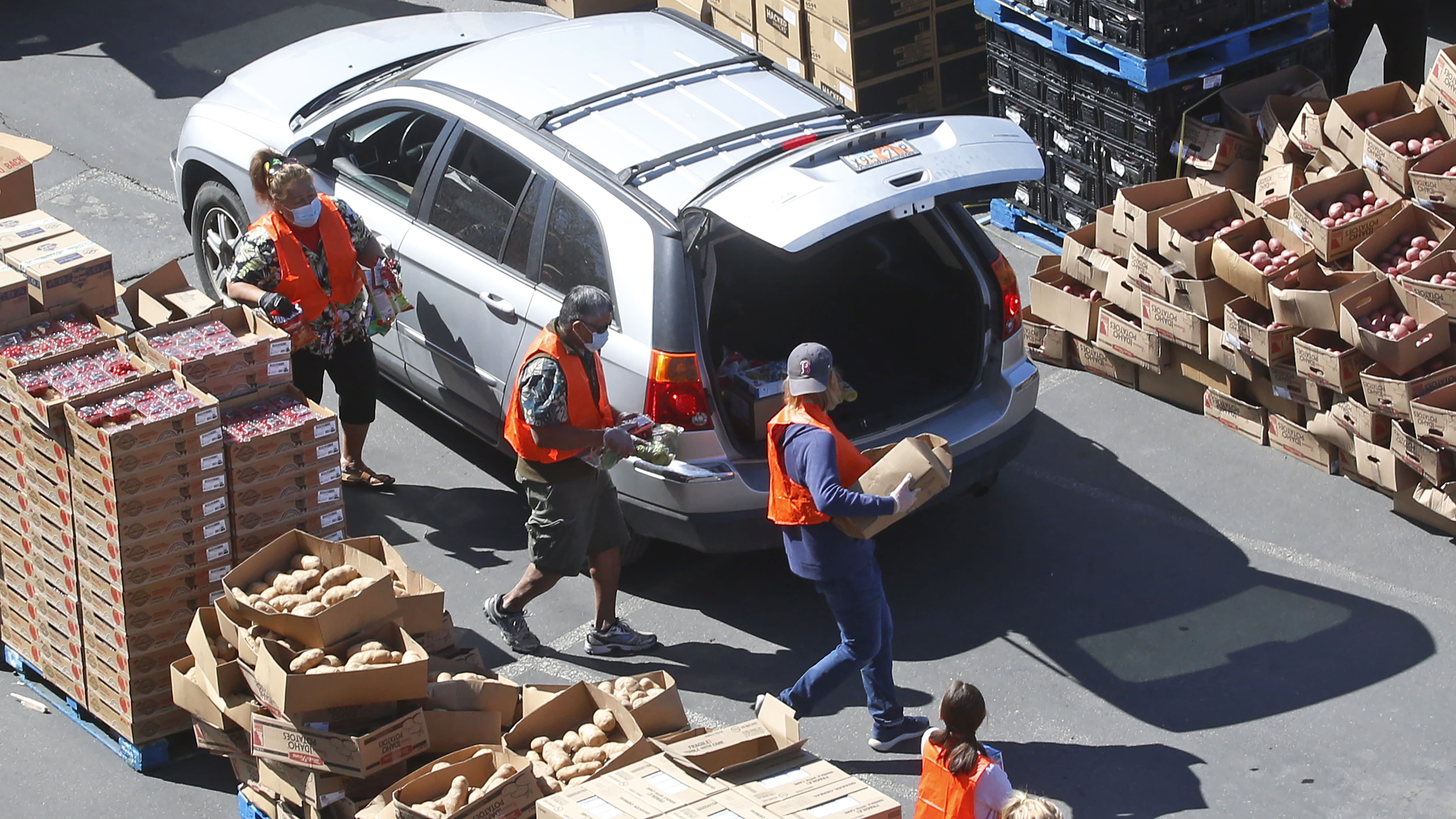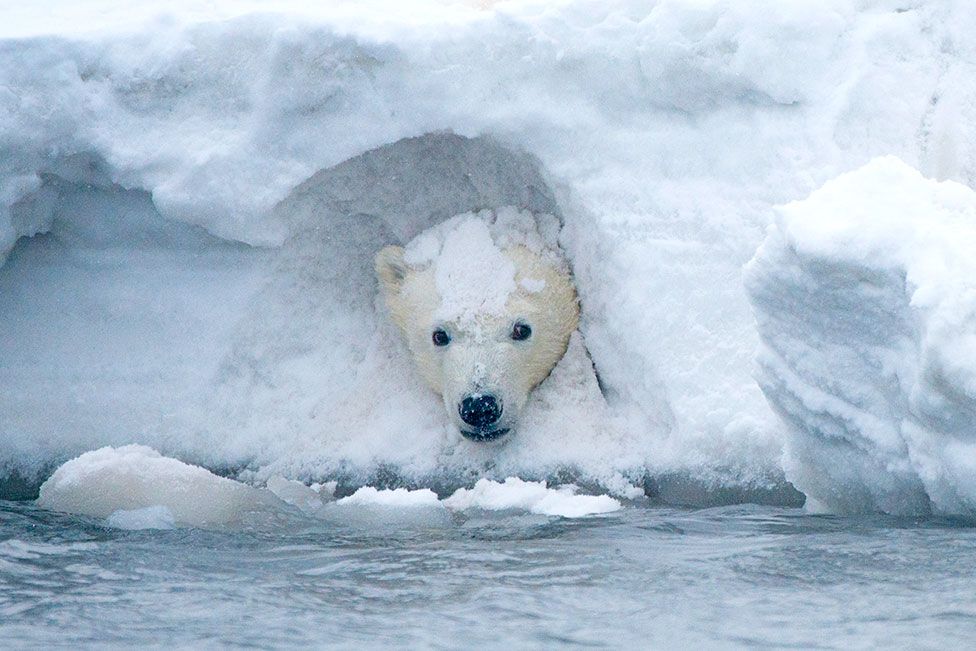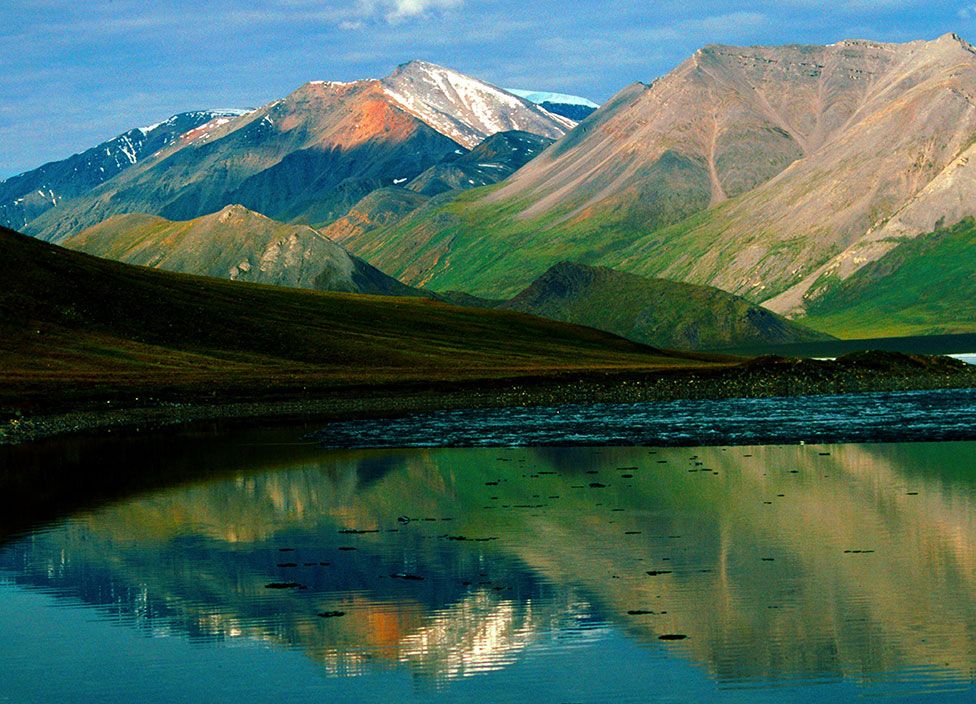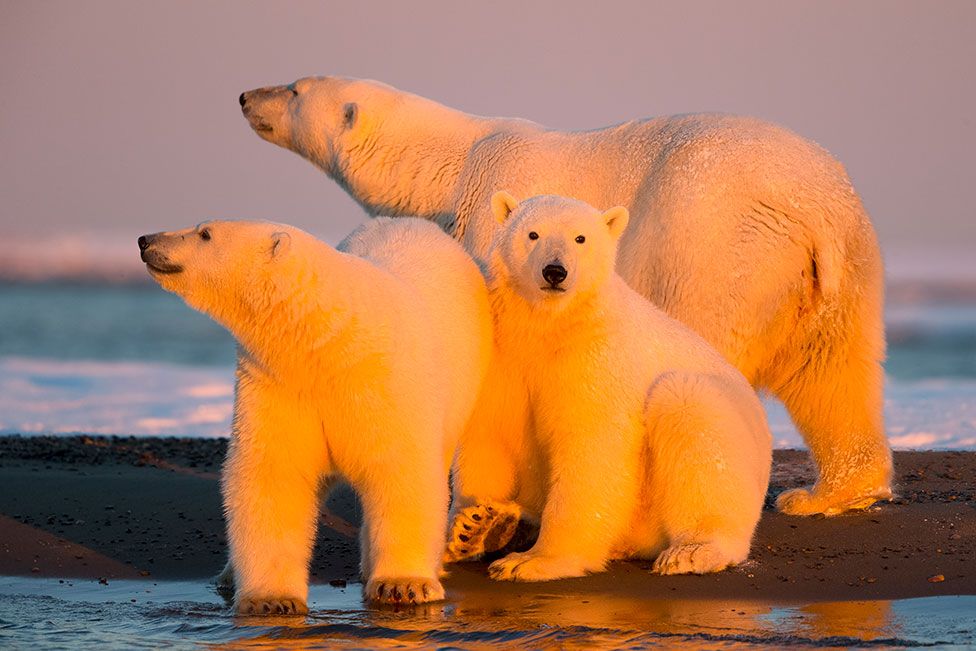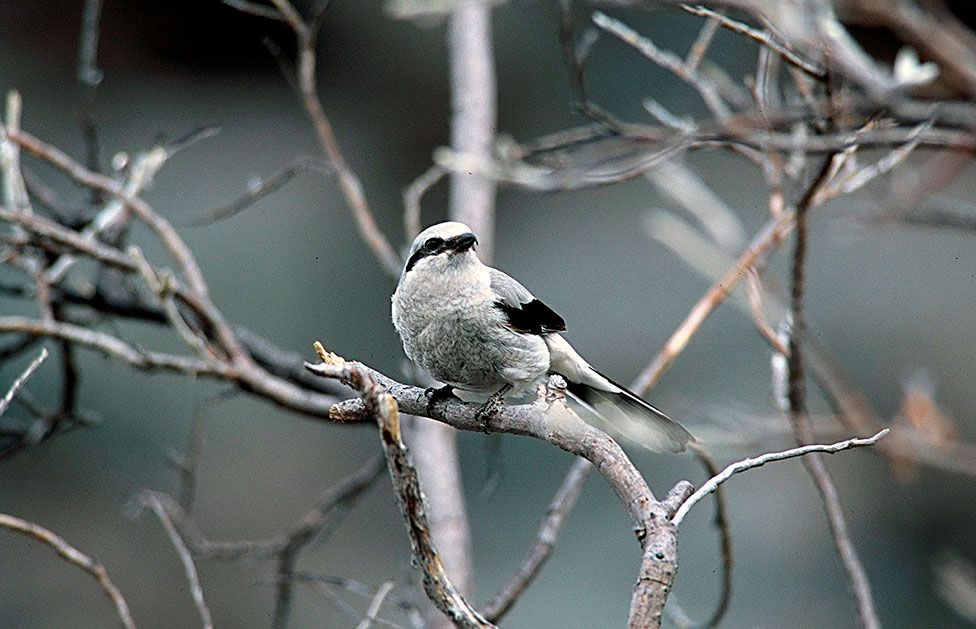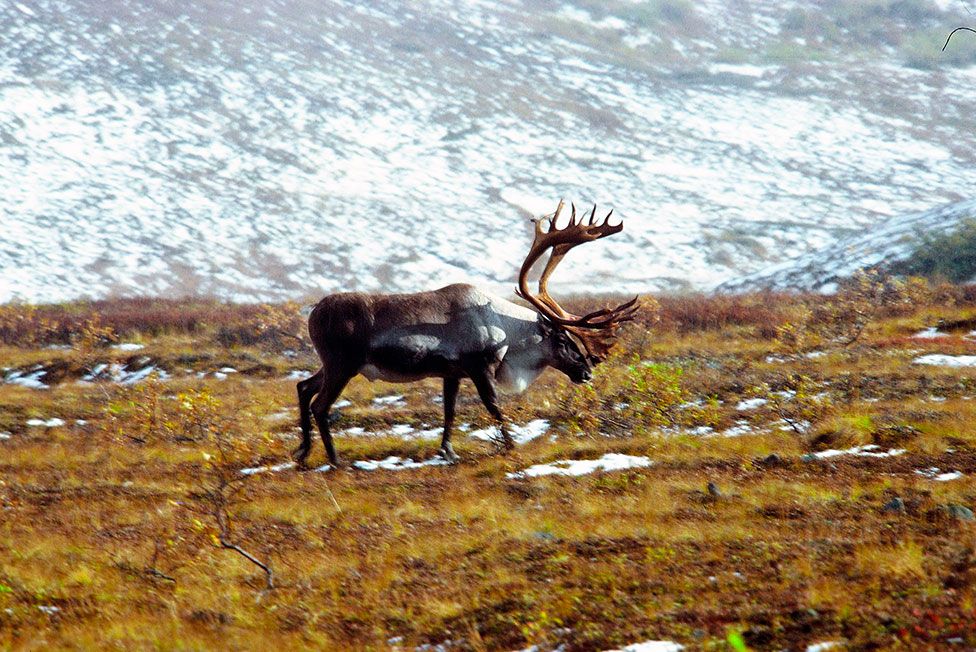LAKESIDE, Calif. — This is America: a family crammed in a minivan driving mile after mile across San Diego County, first to one food giveaway and then to another and then to more.
To Mary’s Donuts, in rustic downtown Lakeside, for day-old chocolate frosted, maple-and-bacon glazed and pastries the size of catcher’s mitts.
Sixteen miles west to Jewish Family Service for big, fresh mangoes, boxes of hard-boiled eggs, cheese and lamb stew. Another 20 minutes south to the Ocean Discovery Institute for diapers and school supplies. To the Salvation Army for bottled water, oatmeal, a cake. All of it piled high into the back.
Since the coronavirus pandemic upended her life and so many others’, Alexis Frost Cazimero has spent most days this way, gathering food for her four children as well as neighbors in need. She pulls her packed silver Volkswagen van alongside the BMWs and Mercedeses as they edge their way through the long, snaking food lines. Where else but America can luxury and poverty get so close together that, in essence, they become one?
“I want people to understand, the face of the needy is different now,” said Cazimero, who has joined a new class of Americans who never imagined they would have to take a spot in a modern-day bread line. “Just because I have a car doesn’t mean I have enough money to buy food.”
The pandemic has exposed the fragile nature of success for millions of Americans: material markers of outward stability, if not prosperity, but next to nothing to fall back on when times get tough.
In long conversations around the country in August — at kitchen tables, in living rooms and in cars during slow-moving food lines with rambunctious children in the back — Americans reflected on their new reality. The shame and embarrassment. The loss of choice in something as basic as what to eat. The worry over how to make sure their children get a healthy diet. The fear that their lives will never get back on track.
There was the family in Jackson, Mississippi, that relied on a local food bank over the summer, even though before the pandemic they had been making almost six figures a year. That is a nice living in a place like Jackson, and it got them a house in the leafy Belhaven neighborhood, a Chevy Suburban and beach vacations to Florida.
Or the single mother in Tennessee who had finally pushed her way into the middle class with a job that paid enough to send her oldest daughter to private school, only to find herself accepting food from charity.
Cazimero, 40, faced her new financial circumstances with as much equanimity as determination, even as it shook her sense of what it meant to have made it. Before the pandemic, she was a hair stylist at a salon owned by her mother-in-law that would shut down in accordance with California’s coronavirus rules. She also ran her own events business, which had been “rocking and rolling” after a lucrative holiday season decking out car dealerships for Christmas. Her husband, Adam, saw far fewer people come into the local Ford dealership where he works, and his commissions have plummeted.
These days she has become an armchair therapist to friends who feel ashamed at not being able to afford enough food; a logistics specialist in how she navigates the schedules of all the pantries in San Diego County; and a food procurer and distributor to the needy, even as she is needy herself.
“Before, I always helped out,” she said. “But I wasn’t the one who needed it. Now I need it.”
After making her rounds, Cazimero returned to her modest house in a development studding a hillside and separated out what will go to her family and what she will give away to neighbors and others. Over Facebook and text message groups, informal barter networks have sprouted among needy families. “You have toilet paper? Let’s trade,” she said.
And then there are the private messages from friends saying they need help but are embarrassed at not being able to provide for their families anymore.
She reminds them they are not the only ones. “Dude,” she said, “none of us can because we can’t work.”
‘The Great Depression With Minivans’
When historians look back on our pandemic-stricken times, there will perhaps be one indelible image that captures the attention of future generations: the endless lines of cars across the country filled with hungry Americans.
“I call it the Great Depression with minivans,” said Terry McNamara, who on a recent morning was behind the wheel in a line of cars, their trunks opened as they wound through the parking lot of Parma Senior High School in a working-class suburb of Cleveland that was once America’s fastest-growing city.
With his daughter, Laura Horsburgh, and five grandchildren along for the ride, McNamara, 74, drove his car through the procession as it moved along with military precision. At each station a coach or a teacher or even the principal loaded up the trunk with milk, or fresh produce from local farms — sometimes plump tomatoes or corn on the cob — or boxes of soup and lentils and cans of tuna. How much food one got depended on how many children were in the car. At the last stop, inside the school’s auto repair shop, volunteers offered watermelons and storybooks — Dr. Seuss and Berenstain Bears.
“The kids love to go and see what is new,” Horsburgh said.
The numbers of Americans seeking help from food banks have swelled despite an unprecedented expansion of the federal government’s food stamp program in the midst of the pandemic.
Just one food bank in Memphis, Tennessee, served more than 18,000 people between March and August, 10 times as many as over the same period last year.
“Folks who had really good jobs and were able to pay their bills and never knew how to find us,” said Ephie Johnson, the president and chief executive of Neighborhood Christian Centers. “A lot of people had finally landed that job, were helping their family and able to do a little better, and then this takes you out.” In her 30 years of charitable work in Memphis, she said, “I have not seen it quite like this.”
In one week in late July nearly 30 million Americans reported they did not have enough to eat, according to a government survey. Among households with children, 1 in 3 reported insufficient food, the highest level in the nearly two decades the government has tracked hunger in America, said Lauren Bauer, who studies food insecurity at the Brookings Institution.
“What’s happening with children right now is unprecedented in modern times,” Bauer said.
As painful as the summer was, as difficult as it became for so many families to afford decent food, the situation could get worse, especially with unemployment benefits drying up for many people and Washington unable to agree on a new stimulus package. Then there is the virus itself: It could surge back in the fall and shutter businesses again, putting more people out of work and into the food lines.
Feeding America, which oversees the country’s largest network of food banks and pantries, has projected that up to 54 million Americans could be food insecure before the end of the year, a 46% increase since the pandemic began. The group has reported a 60% increase in the number of people it serves and said that 4 in 10 people are first-time recipients of food aid.
During the pandemic, Feeding America’s volunteers have surveyed recipients, sending dispatches back to headquarters that read like raw intelligence reports from a nation in need.
“It was obvious that several people who came through our drive-through mobile pantry had never been to a pantry before,” reads one account from Terre Haute, Indiana.
In Cleveland, a woman who had once been prosperous enough to be a donor to the local food bank found herself on the receiving end, collecting food and also flowers on Mother’s Day.
In July, a report came back from New Orleans: “We have met so many people who are seeking the assistance from a food bank for the first time. In a ‘normal’ year, it’s not uncommon to hear someone say, ‘Six months ago, I never dreamed I’d need to ask for help getting food.’ But over the course of the pandemic response the number of people telling us has grown by magnitudes.”
What the numbers do not capture is the powerful emotions of shame or embarrassment that many say they feel, having fallen so suddenly into the lines of the desperate, and seeing so many hard-earned prizes of middle-class life — the nice car, the vacations, the ability to buy what they want when they want — fall away.
Ciara Jones, a single mother in Memphis, grew up poor but in recent years worked her way to economic stability. She was hired last year as a manager at Logan’s Roadhouse, a restaurant chain in the South, earning $60,000 a year — more money than she had ever made. She put her oldest daughter in a private Christian school, bought a new white Honda Accord and took her four children on vacation to Six Flags in St. Louis.
“I felt myself finally in the middle class,” Jones, 33, said.
Then the pandemic hit, and Logan’s closed, but not before she was allowed to take home T-bone steaks and chicken wings and hamburger patties from the restaurant’s freezer, which helped for a little while. And so did the extra $600 a week in unemployment she was receiving. But that has run out, and now she is receiving $275 per week in benefits, barely enough to cover her monthly rent of $975. She said she was ashamed to get food from Neighborhood Christian Centers and is embarrassed every time she pulls out her food stamp card at the grocery store.
“I’ve always been a strong woman, a strong mother,” she said. “I don’t want my kids to see me struggle or stressed.”
They Thought Poverty Was in the Rearview Mirror
The Belhaven neighborhood of Jackson, Mississippi, is filled with charming bungalows, stately old homes and canopied streets. Lily Victory lives in a small, white clapboard house on the edge of the neighborhood.
As a child, Victory was in foster care sometimes and grew up “super-poor,” she said. Food was always scarce. Her parents, she said, were too proud to apply for discounted lunches, so she never ate at school.
Before the pandemic, she worked as a contractor with the military. Her husband, Mike, is a machinist at a box factory, and together they earned a little less than $100,000 a year.
“We had nothing to worry about,” she said. “We had savings. We were saving up to put a down payment on a house. We took a couple vacations a year. The kids got whatever they wanted.”
After losing her job, and after her husband’s hours were cut, they were soon staring at an eviction notice. They were unable to make the $1,100 rent payment. The Chevy Suburban was one of the first things to go. Every day she awoke to a feeling of “impending doom.”
She called around to social service organizations and churches searching for help paying the rent. She was instead directed to a food bank, the Good Samaritan Center. Save the money you would spend on food and put it toward rent, she was told.
“I thought about a food bank and I was like, I don’t want to do that because if you are going to a food bank you really need it,” she said as she barely touched her lunch at a Mediterranean restaurant in Jackson. “I didn’t want to take it away from someone.”
She went anyway, as painful as it was.
“I lied to my children,” she said, her eyes unblinking.
To explain why there were so many things she did not normally buy — like cans of Coke and Sprite, or boxes of cupcakes — she told them they were a special treat because they were cooped up in the house. And to explain why she was not buying usual items like Lunchables, she said the shelves at the grocery store were bare because of the pandemic.
Amid Struggle, Gratitude and Silver Linings
As she drove from one food pantry to another in eastern San Diego County, Cazimero pointed out some of the businesses that have closed permanently. She passed through the center of El Cajon, her hometown, where she used to put up Christmas decorations at the promenade.
She was on her way to pass out doughnuts at a trailer community in the shadow of a busy freeway. Helping others find food, she said, has brought her purpose. She may have less money now, but she also has less anxiety. That is because she no longer is driven to exhaustion managing the children and work. There is no work anymore.
“I can go with less, and we have spent so much more valuable time as a family,” she said.
About 2,500 miles and three time zones away, in Erie, Pennsylvania, Claire Hudson, a single mother, lost her customer service job. For the first time, she went to a food bank. Like millions of Americans, she suddenly had little choice in what to eat, forced to accept whatever is boxed up and loaded in the trunk.
Many food banks offer fresh produce from local farms and prime cuts of meat. But giveaway boxes are often stuffed with bread and cakes and cookies.
“In the richest country in the world, and we are, we make it so easy to be unhealthy,” Cazimero said.
The crisis of food insecurity has further exposed how an unhealthy diet contributes to conditions like obesity and diabetes that put people at higher risk for complications from the virus.
With little choice, Hudson picked out what she and her son could use and donated the rest to those even more in need. She noticed a growing homeless population so started stuffing what she called “blessing bags” with sugary cereals like Froot Loops, graham crackers and pudding.
When she began handing them out to homeless people, she let them pick what they liked. “I started giving them a choice,” she said. “Hey, this is what I have, does any of this interest you? The choice for me came from not having a choice in what we got.”
Back in Ohio, Horsburgh, a stay-at-home mother, and her husband, Chris, a house painter whose jobs dwindled when the pandemic hit, worry plenty about money. But the children look forward to the weekly outings to the high school parking lot to pick up food — a routine in an uncertain time.
As the pandemic drags on, our understanding of the nature of the needy in the United States is changing, and with that change new questions abound: What is our responsibility to those who can barely hang on? Will we think differently about who has to ask for help and why?
Cazimero said she was trying to be optimistic: “Something great is going to come of this.”
But no one knows what the road back for so many families looks like — or if they can even make it back.
“You could grit and grind as a 19-year-old, until you get to 25 or 30, and you’re finally getting there,” said Johnson, the head of the charity in Memphis. “But at 30, 40 years old now you are trying to start over again? How are you going to do that? It’s hard.”











